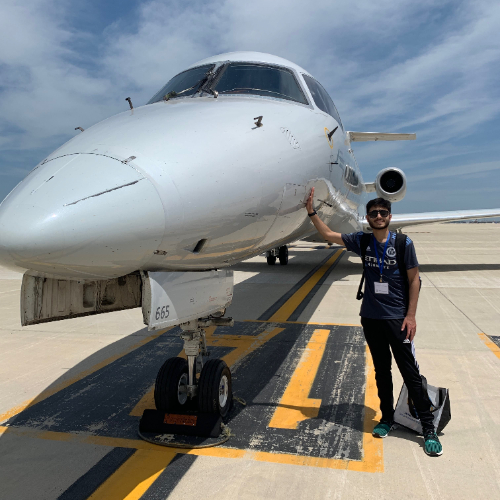
Industries around the world have been suffering from staff shortages since the pandemic. The travel sector, especially aviation, has experienced these struggles first-hand.
In Australia, a staff shortage among air traffic controllers has become a massive concern as many fear that the chances of a collision have risen.
Controller Shortage
A staff shortage at various Australian airport control towers is causing many concerns for pilots having to virtually "fly blind" at nighttime.

Northern Australia's Darwin International Airport (DRW) now offers no air traffic control services at night. This means that around midnight every night, over a dozen flights must manage arrivals and departures without the assistance of controllers.
Townsville Airport (TSV) now does not offer a staffed control tower on weekends in Queensland. As such, pilots of around 50 flights had to coordinate their takeoffs and landings alone last Sunday, according to a report by Bloomberg.
Many air traffic control staff left the industry in Australia following the COVID-19 pandemic. Australia was one country that effectively shut its borders completely during the pandemic, significantly affecting its aviation industry.

With international travel into Australia virtually nonexistent and the frequency of domestic flights already low, many air traffic controllers left their jobs.
Australia's Federal Transport Minister Catherine King reported in August 2023:
"We lost a lot of air traffic controllers. A lot of them took early redundancy because with the planes not flying, the work wasn't there, and the income wasn't coming in."
Even with travel recovering and Australia reopening, the country's air traffic controller situation has worsened.

Darwin Airport has 866 flights scheduled this month, representing the highest amount of flights that the airport has seen this year. This is a massive jump from 171 flights in May 2020, according to Cirium.
Increased Collision Risk
The controller shortage situation has gotten so bad that a Qantas pilot has admitted that a catastrophic incident "would not be surprising."
Tony Lucas, a senior Qantas pilot who is also President of the Australian and International Pilots Association (AIPA), noted that:
"Without air traffic control, the chance of errors by any one aircraft or pilot increases, and the ability to identify and correct those errors is dramatically reduced."

In April, the AIPA issued a safety warning regarding a higher risk of mid-air collisions in some areas.
However, regarding Darwin Airport, the Civil Aviation Safety Authority mentioned it was satisfied with arrangements between 10 pm and 6 am being safe for the anticipated traffic mix.
It is easy to understand why an air traffic controller shortage is so problematic. If you are the pilot of an aircraft, there is little you can see around you.
As the pilot, your main priority is the safe control of the aircraft itself. However, you depend highly on air traffic controllers to safely guide your plane into the air or onto the ground.

This is because air traffic controllers can see your surroundings. They can notify you of any aircraft nearby or any abnormalities that could threaten your plane.
Not having such controllers adds much more stress to the pilots, who already have much to deal with.
Despite suffering from a massive shortage, Australia has recruited 100 new air traffic controllers since 2020, with over 70 more expected to join by the 2025 fiscal year.
Emirates Dismisses Viral A330 Plane Crash Video as "Fabricated and Untrue" » Passengers Encounter Bedbug Infestation on Multiple Turkish Airlines Flights » Thousands of Flights Impacted as Winter Storm Blair Hits U.S. »
Comments (0)
Add Your Comment
SHARE
TAGS
NEWS Australian airportsair traffic controller shortageatc shortageaustralia airport issuedarwin airportRECENTLY PUBLISHED
 Could You Survive a Plane Crash? The Unlikely Science of Plane Crash Survival
With air travel consistently being heralded as the safest form of public transport, most of us do not board a plane pondering our chances of survival in the event of a crash. But, is it possible to survive one?
INFORMATIONAL
READ MORE »
Could You Survive a Plane Crash? The Unlikely Science of Plane Crash Survival
With air travel consistently being heralded as the safest form of public transport, most of us do not board a plane pondering our chances of survival in the event of a crash. But, is it possible to survive one?
INFORMATIONAL
READ MORE »
 Maldivian Airlines Introduces First-Ever Widebody Aircraft, Plans New China Flights
Maldivian, the government-owned national airline of the Maldives, has just welcomed its first-ever wide body aircraft: the Airbus A330-200. With the new aircraft, the carrier also plans brand-new long haul international flights to China.
NEWS
READ MORE »
Maldivian Airlines Introduces First-Ever Widebody Aircraft, Plans New China Flights
Maldivian, the government-owned national airline of the Maldives, has just welcomed its first-ever wide body aircraft: the Airbus A330-200. With the new aircraft, the carrier also plans brand-new long haul international flights to China.
NEWS
READ MORE »
 Thousands of Flights Impacted as Winter Storm Blair Hits U.S.
Winter Storm Blair has unleashed a huge blast of snow, ice, and freezing temperatures across the Central and Eastern United States.
As of Sunday afternoon, over 6,700 flights and counting have been disrupted. This includes cancelations and significant delays leaving passengers scrambling to change flights and adjust travel plans.
NEWS
READ MORE »
Thousands of Flights Impacted as Winter Storm Blair Hits U.S.
Winter Storm Blair has unleashed a huge blast of snow, ice, and freezing temperatures across the Central and Eastern United States.
As of Sunday afternoon, over 6,700 flights and counting have been disrupted. This includes cancelations and significant delays leaving passengers scrambling to change flights and adjust travel plans.
NEWS
READ MORE »





